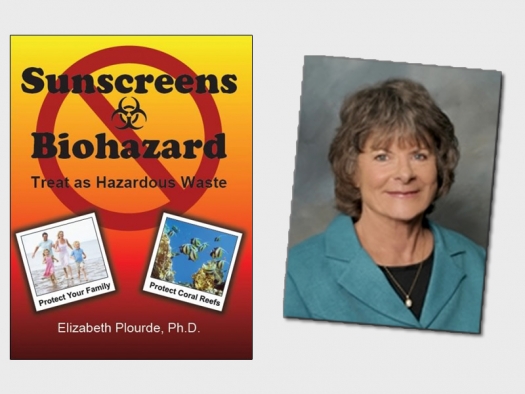Elizabeth Plourde looks at the dangers of sunscreens for people and the environment
Book announcement
SunscreensBiohazardElizabethPlourde.jpg

Sunscreens – Biohazard: Treat as Hazardous Waste by Dr. Elizabeth Plourde
Elizabeth Plourde, CLS, PhD, is a California-based scientist who has spent her career researching various medical topics. While swimming in Hawaii and contemplating the supposed effect of global warming on the loss of coral habitat, it occurred to her that the ocean was actually a lot colder than she remembered. When she began investigating this, she came across data showing that the chemicals in sunscreens can kill coral in 96 hours. This inspired her to complete more research on the subject. She discovered that not only do sunscreens fail to protect us against cancer, they may actually increase it.
Her book, Sunscreens – Biohazard: Treat as Hazardous Waste, provides extensive evidence of the dangers of sunscreens and their negative effect on the environment.
At a recent presentation at the Cancer Control Society Conference in Hollywood, California, Dr. Plourde explained why this is so. According to her research, many sunscreens only protect against UVB rays. These UVB rays are the ones that cause the burning sensation on the epidermis, or outer layer of the skin. Protecting against these rays does indeed stop the burning sensation and coloring effect, but it gives a false sense of safety as it encourages people to stay in the sun longer. Many sunscreens do not stop the sun's UVA and infra-red rays. These other rays penetrate into deeper layers of tissue and are more strongly linked with melanoma. While some newer sunscreens offer protection against UVA, none protect against infra-red.
Dr. Plourde presented research data showing that levels of malignant melanoma and all skin cancers increased significantly as the percentage of sunscreen users rose over time. Many of the chemicals in sunscreens are known carcinogens and also endocrine disrupting chemicals (EDC). These EDCs have properties that disrupt both androgens and estrogens. In areas where there has been much exposure to ED chemicals, coral and other sea populations have died off and the prevalence of dual-sexed fish has risen. Dr. Plourde presented research on mice and sunscreen exposure that showed increases in both pup and maternal mortality as well as reproductive issues in subsequent generations.
To make matters worse, most sunscreen manufacturers use nano particles of titanium and zinc oxide in their formulas. The FDA currently has no requirements for noting the presence of nano particles on cosmetic product labels. Nano particles are so small that they can penetrate cell walls and cross the blood-brain barrier. This leads to more cell oxidation and damage, further increasing the possibility of skin cancer and other potential long-term side effects.
Sadly, sunscreen residues have polluted many of our water sources, including not just oceans but inland lakes, rivers and municipal drinking water. Testing has shown that 97% of Americans have sunscreen chemicals in their blood. These chemicals can pass through the placenta and are found in breast milk. EDCs can alter male/female sex differentiation, cause men's breasts to grow, impact brain development, disrupt thyroid function and impact both male and female fertility. Sunscreen also leads to Vitamin D deficiency which is increasingly linked to reduced immunity, cancer, auto-immune issues and a number of other health issues.
What can you do?
- Stop using sunscreens and petition manufacturers to remove toxic chemicals from their products.
- If a tan is your objective, your body's melanin is your best protection. Start with 10-20 minutes per day, gradually increasing sun exposure over time.
- Use hats and clothing to cover up.
- Make your own sunscreen. There are several great recipes on the internet. Be careful about recipes that use zinc oxide – you may need to ask the product manufacturer if it is really free of nano particles. Also, there is also some evidence that zinc oxide is harmful to fish.
- Sunshine provides Vitamin D, a nutrient critical to our health. The sun is not our enemy and we need to use it wisely.
- Learn more and spread the word. Read Dr. Plourde's book: Sunscreens – Biohazard: Treat as Hazardous Waste, available at Amazon.

